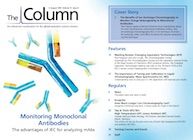Measuring Chitosan Molecular Weight Using AF4–MALS-RI
A new method for the accurate molecular weight determination of the complex polysaccharides chitosans has been developed using asymmetric AF4 coupled with MALS and differential RI detectors.
Photo Credit: Artem Shadrin/stock.adobe.com

A new method for the accurate molecular weight determination of the complex polysaccharides chitosans has been developed using asymmetric flow field-flow fractionation (AF4) coupled with multi-angle light scattering (MALS) and differential refractive index (RI) detectors (1).
A highly sought-after biopolymer, chitosans have multiple functions with well over 200 current and potential applications across a wide range of scientific areas. They can be biologically sourced from the exoskeletons of various crustaceans and insects, as well as the cell walls of certain fungi and fish scales; however, many of its material and biological properties are heavily linked to the molecular weight (MW) of the polymer. Therefore, an accurate MW is crucial to the effective utilization of chitosans in industry.
Unfortunately, the actual task of accurate MW measurement is complicated by their biological source, which can vary greatly and also be affected by parameters such as the season of harvest, or the process of isolation of chitin and the deacetylation into chitosan. The traditional technique used for chitosan MW measurement has been size-exclusion chromatography (SEC); however, for more complex polysaccharides such as chitosans the use of SEC requires prefiltration of samples to remove interfering aggregate fractions, which is a time-consuming process and can lead to considerable sample loss.
The new method described by researchers uses AF4–MALS-RI to separate the polymer from the molecular aggregates found in chitosan solutions. The technique has the added advantage of being able to identify the aggregates present as well as separate them, thereby allowing the determination of MW for a wide range of chitosans while avoiding the sample loss found when using conventional SEC–MALS-RI methods. This was particularly evident for high-molecular-weight chitosans where the required filtration step prior to SEC resulted in a significant sample loss.
Reference
- Y. González-Espinosa et al., Int. J. Biol. Macromol.136, 911–919 (2019).

Determining Enhanced Sensitivity to Odors due to Anxiety-Associated Chemosignals with GC
May 8th 2025Based on their hypothesis that smelling anxiety chemosignals can, like visual anxiety induction, lead to an increase in odor sensitivity, a joint study between the University of Erlangen-Nuremberg (Erlangen, Germany) and the Fraunhofer Institute for Process Engineering and Packaging (Freising, Germany) combined behavioral experiments, odor profile analysis by a trained panel, and instrumental analysis of odorants (gas chromatography-olfactometry) and volatiles (gas chromatography-mass spectrometry).
Investigating 3D-Printable Stationary Phases in Liquid Chromatography
May 7th 20253D printing technology has potential in chromatography, but a major challenge is developing materials with both high porosity and robust mechanical properties. Recently, scientists compared the separation performances of eight different 3D printable stationary phases.
Detecting Hyper-Fast Chromatographic Peaks Using Ion Mobility Spectrometry
May 6th 2025Ion mobility spectrometers can detect trace compounds quickly, though they can face various issues with detecting certain peaks. University of Hannover scientists created a new system for resolving hyper-fast gas chromatography (GC) peaks.

.png&w=3840&q=75)

.png&w=3840&q=75)



.png&w=3840&q=75)



.png&w=3840&q=75)










